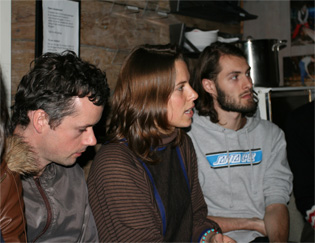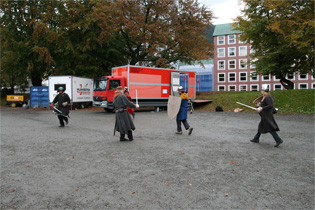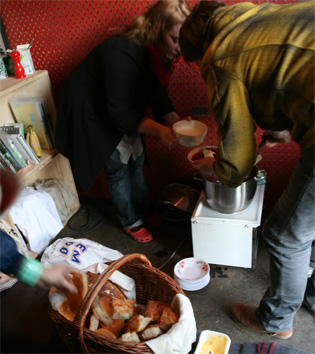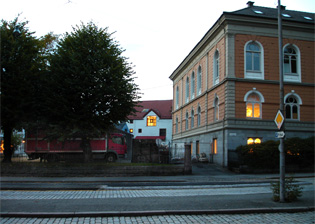
03.10 - Lecture by Bik Van der Pol
Being a source of inspiration for Rakett, our projects and collaboration, we where honored to host the artist duo Bik Van Der Pol on their first visit to Norway.
In collaboration with Øystein Hauge and his Wednesday Seminar Program at Bergen National Academy of Art, Bik Van Der Pol was invited to give a presentation on their collaboration and artistic practice. The duo where showing documentation and introducing projects like The Kitchen Piece (1995), The Bookshop Piece (1996), Sleep With Me (1997- onwards), Fly Me To The Moon (2006) and more. Documentation from all of the projects mentioned are made available on their website www.bikvanderpol.net
Bik Van der Pol (Liesbeth Bik and Jos van der Pol) work collectively
since 1995 as Bik Van der Pol. They live and work in Rotterdam.
Their projects engage with functionality and site sensitivity,
concerned with interaction at an institutional and intimate, local
level. They engage with revitalization of memory in the present and
with questions of knowledge, thus creating the necessary potential for
a dialogue and an ever reforming discourse through which they develop
an understanding of situations that surround us. They aim to improve
situations, add what is missing, highlight what is in the dark and to
open rather than close. Their working method is based on co-operation
and they use this as a platform for various kinds of communicative
activities. Exploring and activating such platforms is one of the main
threads in their work.
|

The Archive during todays closed hours. Located outside Bergen National Academy of Arts next to the railway station.
|
|

Open Archive. Karolin makes waffels to the visitors hidden inside the Archive. Photo by Åse Løvgren

Located behind Johannes Church in the centre of Bergen city.
Photo by Åse Løvgren |
30.09 - Reading the archive, with Henk Slager
Art as knowledge production
A handful people made it to the Sunday reading group at the Natural History Museum in Bergen. A location deliberately chosen for its relation to a certain type of knowledge production that might be associated with dusty displays and systematic presentations.
Henk Slager had chosen a text by Sarat Maharaj which originates from a conference about artistic research held in Holland a few years back. The text’s fragmented structure was well-suited for the reading group, and the group read paragraph by paragraph discussing the implications of the text as the reading progressed.
Maharaj’s text thinks about how art as a producer of knowledge can operate seen in comparison to the academic sciences. Following the text, the discussion circled around how art can cut across established knowledge structures and invent its own method. The conversation also took a sidetrack exchange about the place of theory within art and art education.
Henk Slager has a special interest in how artistic PhDs are being developed in different countries in Europe at the moment, and was curious about the Norwegian development. Sadly, by the sound of a bell, the museum stopped producing knowledge at 4pm that afternoon, which also meant the end of the reading group. The strategy of leaving the audience wanting more is well known, and in this case it proved productive as it left many of the best questions waiting to be discussed.
Text by Morten Torgersrud
---
The text by Sarat Maharaj is downloadable here.
|

Reading with Henk Shlager at the Natural History Museum in Bergen.
Photo by Åse Løvgren
|
29.09 - Living Catalogue
About the Go-Between and Living Catalogue event at Bryggen, Bergen Norway the 29.09.07
The Go-Between project was developed as part of a curatorial course at
de Appel arts centre in Amsterdam. This programme appears to gather a
group of 6 people from diverse backgrounds, countries and practices, to devise a curatorial exhibition project together. For this meeting as part of Rakett's Curating Degree Zero Archive programme, members of the curatorial team, as well as their tutor in theory at de Appel, were present.
I could group what I recall of the meeting into two realms of discussion:
The format of the Living catalogue as a way of evidencing a specific
curatorial process, and the project itself, its relationships with the
artists, the problematic of the space, and issues inherent to this area of
Amsterdam, de Bijlmer district.
The definition of a Living Catalogue was implied as one that is not in
print. This would permit the project to escape certain institutional
connotations, especially sensitive in this project; working in de Bijlmer
might represent a particular institutional interest that could contravene
the curators' own intentions. The tensions between an institutional and an
artistic agenda were discussed. Later, a film was shown, a documentary made by an artist (a hip hop filmaker) who lives in de Bijlmer, and who was commissioned to explore the workings of the project from his own particular reading. It was noted that the film ended up providing the elements of a catalogue in a different format. The distance from a conventional printed catalogue, nonetheless, allowed for a particular insight on the different dynamics of the Go-Between, it triggered questions as to where the art might be activated, as well as the various vantage points and further questions from the curators who seemed to still be interested in re- assessing the components of the project.
As for the project itself, the degrees of effectiveness - and criteria for measuring effectiveness- were also discussed. Although some of the pieces
seemed to interact more with de Bijlmer than others, it was difficult to
reduce the problem of effectiveness to a mere presence in the geographic
space at hand.
For the participants of the Go-Between the questions of the inclusion of an artistic project in a sensitive part of a city, the modes of documentation and circulation of a group of pieces and a reflective agenda, as well as the issues inherent to a collaboration of several different curators taking part of a programme with the profile of an institution such as deAppel, seem to demand dynamic and malleable notions of exhibition and documentation. This all seems to make the idea of a "living catalogue" relevant, necessary, and of course of great interest to those of us attending on that day.
Text by Pedro Gómez-Egaña
---
Living Catalogue
- If you write a story down, do you kill it?
Putting something to print, means giving it permanence, making it available to everyone (who can get their hands on it, and who can read) in duplicated form over time. The printed word still has an authority, difficult to dispute. More commanding and reliable than hearsay, a printed document is seemingly robust, traveling through the future, while constantly telling of its past.
With the Living Catalogue, the curators challenge this notion by choosing to communicate their collaborative project The Go-Between via the medium of presentations, talks, events, film screenings, interviews, food give-aways and discussions, in as many locations that show interest to host this choice of format.
The Go-Between is a series of nine ephemeral art projects exploring process-based ways of working, developed since the beginning of 2007 in and around an apartment in one of the characteristic blocks of the Bijlmer, a suburb in the South-East of Amsterdam. Aware of the negative impacts of short-lived cultural projects in local neighbourhoods, the curators of the The Go-Between decided on not giving a ‘full stop’ to their activities by either limiting the art projects to the short term (both artists’ Mark Hosking and Frank Koolen’s works live beyond the time frame of The Go-Between), or delivering a printed publication retrospectively summarising the project as a reference document.
The idea of a tale, taken on the road and woven in a variety of locations, echoes the actions of the first traveling bards, poets and minstrel bands and reminds us of the root of storytelling - the predecessor of the printed word. The organizers of the Living Catalogue, enthusiastic about the potential of a morphing portrayal of The Go-Between are testing how long the story can avoid being ’set in stone’ and with this approach, extend both the life and possibilities of the project and summon up a new cultural tool at the same time.
The Living Catalogue Tour 2007:
September 2007
- Curating Degree Zero, Bergen, Norway
October 2007
- de Appel Arts Center, Amsterdam, The Netherlands
- Monkeytown, New York
November 2007:
- Your Space, Van AbbeMuseum, Eindhoven, The Netherlands
Upcoming 2008:
- Santiago, Chile
- Buenos Aires, Argentina
- Los Angeles, USA
If you are interested in hosting a Living Catalogue event please contact us. More about The Living Catalogue
---
Thanks to Stiftelsen Bryggen
|

Members of the Living Catalogue, Andrew Cannon and Camila Marambio, part of performing the first presentation event at Bryggen in Bergen. Photo by Åse Løvgren

Cooking Degree Zero chef Torill Johannesen presenting her Medieval Pea soup that blended perfectly in the historical Hansa surroundings.
Photo by Åse Løvgren

Open Archive. Visiting Vikings actively sword-training inside the fort just before they got offered our red coloured leftovers from the previous day. Photo by Åse Løvgren
|
28.09 - Sex Tags Mania presents Skeleton
17:30 presentation by Franz Pomassl and Sex Tags
Inside the red lorry, parked on this medieval ground, Rakett presents the guests Franz Pommasl and Anna Ceeh - artists and producers with great collaborative practice and artistic projects. We, a gang of 12, also meet Stefan and Peter aka Sex Tags from Bergen, publishers of printed matters, visual and audible, organizers of techno music events and now, the co-makers of Skeleton, 12” and a concert with Franz Pomassl.
The presentation lasts for 2 beers as the smell of Russian Borscht spreads through the small archive space while Franz tells us how the 12 ” Skeleton first time arose from the new situation in Austria in the 90's, where the laptop technology and cheap print fact in CZ and HU, allowed anyone to release their own independent music; need of recontextualisation resulted also in a bunch of new magazines. Franz, trained as a painter, meant to see lost power in the visual art scene and unused potential in the sound/music field so he started the label Laton and in 1996 he released Skeleton, a 12” vinyl on Sabotage Records which had a great success. It was followed by Skeleton no. 2, one year later wich contained no changes except for a few swoped titles, but the music journalists didn't notice and applauded the record more than ever, unaware that they clapped them self into the top league of superficial journalism. ”Minimal action for maximal output” is Franz' comment. Skeleton 3, produced in 2006, swoped track titles and artists and no. 4 changed unchanged into a CD.
Now, Skeleton 5 is produced together with Sex Tags Mania, again a 12” vinyl including remixes and added material from the Laton archive.
The present network concept of Laton began in 2002 when Anna Ceeh (St.Petersburg) joined and they started travelling and performing in former Ukraine, the Baltic countries and Russia where they are documenting and tracing previously unknown music regions and musicians from cities like Murmansk, Petrozavodsk, Vladivostock. Their engagement has led to two new music festivals in Siberia and Kamchatka. Laton has allready released ten CD´s with music from former Sovjet Union and thanks to Franz and Annas collaborative initiatives possibilities for people to travel, make concert and join the daily business of the music scene in West Europe are made, step by step.
A voice breaks through the wagon; Borscht on the road, people!
Text by Siri Austeen
---
More about Sex Tags Mania presents Skeleton, 12" release and concert here.
|

The archive located inside the Bergenhus fort, in the background, Håkonshallen. Photo by Karolin Tampere

Anna Ceeh and Franz Pomassl presenting their collaborative project and recordlabel Laton and their newest co-release with artist duo Sex Tags. Photo by Åse Løvgren

Cooking Degree Zero team Borghild and Sveinung Unneland fine tuning their deep red Borscht soup. Photo by Karolin Tampere

Franz Pomassl during his Skeleton concert performance, deep down in the secret and hidden Sex Tags basement location. Photo by Stefan Mitterer
|
26.09 - Part I: Open lecture by Yvette Brackman
The Catalyst by Yvette Brackman
Yvette Brackman gave a presentation on her ongoing project Common Knowledge at Bergen Academy of Fine Arts. Through inviting participants from the audience to read her play The Catalyst, which is based on actual events from her ongoing project Common Knowledge, she created a performative lecture in which certain issues concerning copyright and production was adressed. The play is inspired from Brechts learning plays and functioned as an interesting collaborative performance between the audience, artist and the performers.
Common Knowledge is an association between three parties - Yvette Brackman, a group of indigenous craftspeople in the village of Lovozero on the Kola Peninsula in Russia and Camper Shoes, an international shoe company. In initiating a collaboration between indigenous peoples and advanced capitalist production, Brackman has initiated a framework which highlights the problematics of producing a product intended to satisfy cultural, sustainable, artistic, traditional and economic requirements.
The Catalyst with: Stage Manager, Director, Inhabitant, Resident, Native, Specialist, Advocate, Insurgent
---
26.09 - Part II: Medical Meal at Fløyen by Geir Tore Holm
On Fløyen Mountain, by Skomakerdiket, the sun is shining on the trees which have their autumn dresses on. By the water a group of people are making a meal around a fire. Full of expectations we gather around. The sun sets making the air cooler – It would be nice with something warm and we appreciate the cup of herbal tea that is given to us. It will improve your digestion, Geir Tore Holm informes us. He is ready to tell us about the medical meal that he has invited us to.
The tea contains Caraway and was it also milfoil? -Which is good for the digestion, the caraway has been used for more than five thousand years – a genuinely old cultivated plant.
Geir Tore Holm expressed his worry about today's frozen-pizza-eating students and gave his reasons for his commitment to make the medical meal as an attempt to enhance the use of herbs for health reasons. He solemnly declared that all the goods were ecological and that they had tried to get hold on food that was produced as locally as possible. Holm wanted to focus on our use of herbs, both in making food and in health enhancing remedies, a knowledge that has been cast aside by today's fast food culture.
Into the boiling casserole on the fire, Holm had prepared potetoes- ecological ones, that was prepared with flour of seaweed to add taste. This was a somewhat unusual combination that Holm hadn't tried out before. Holm reassured us by stating that the seaweed would contribute with a better taste and at the same time cleanse the body for heavy metals – and that sounded good. On the fire was also placed Norwegian apples with the seeds removed, filled with honey and lemon balm, a herb that is soothing on the nerve system, and has a positive effect on irritability, anxiety and insomnia.
During the meal Holm invited to a talk about herbs. We got to know herbs like wormwood (known ingredient in Absinth) and sage (which is good for tooth ache, by the way). A recommended herb-cocktail for tea on hang-over days can be rosemary and basil – strengthening and soothing fringy nerves. Basil also has a positive effect for nausea. If you have head ache you can find a willow to chew because it contains SALISYLSYRE used in Paracetamol. Or one could do as the Vikings and establish a farm of Garden Angelica, because this was an important source of vitamn c in those days. More herbs and plants were mentioned during the talk which hopefully inspired the partisipants to rediscover ancient knowledge and look for other alternatives than frozen- and fast food.
We left Skomakerdiket free of heavy metals and with a strengthened digestion, ready to meet Bergen on a beautiful autumn night.
Text by Hege Tapio
---
|

The Catalyst, performed by people from the audience at Bergen Academy of Fine Arts. In the background an ongoing slideshow with pictures from the actual events the play is based upon. Photo by Stefan Mitterer

Find-the-archive. Photo by Karolin Tampere

Geir Tore Holm preparing the Medical Meal at Fløien, the city mountain in Bergen. Photo by Kari Anne Østrem

Geir Tore Holm and Rakett serving the Medical Meal.
Photo by Kari Anne Østrem |
25.09 - Open Archive
The archive was located at Nygårdshøyden, very close to the University's department of Humanistic science and behind the red Johannes church. We were hoping to capture some young becoming art-historians, into our van of contemporary practice. To our surprise and great joy, Rakett's favourite librarian Karen Grüner Larsen showed up. She is taking care of the library at the Fine Art Academy in Bergen. She had of course already encountered many of the books and materials in the CDZ archive, but found some titles that soon will be seen in her library. Today's Cooking Degree Zero was Åse Løvgren, who had made a tasty Tomato-soup.
|

Surroundings of the mobile unit. Photo by Åse Løvgren

Location at Universitetshøyden. Photo by Karolin Tampere |
23.09 - Open Archive
Windy, stormy, rainy day in Bergen. On the very edge of Bergen, again at Nordnesparken, the archive threatened to dive into the sea because of the strong wind. The visitors that fought their way through the weather was awarded with "Lapskaus", a traditional Norwegian heavy stew, made of beef, salty lamb meat and vegetables growing beneath the ground. Todays chef was Åse Løvgren with her mother Reidun Løvgren just a phone call away.
Rakett had an talk with visitor Bjørg Taranger around the role of the curator as someone artists can use to bounce back ideas to, and also be a partner in talks and development of art projects. A perfect day for reading and discussing different publications, strategies and ideas represented in the archive.
---
Interview in Billedkunst
|

Cooking Degree Zero in stormy weather. Photo by Karolin Tampere |
22.09 - Phonophani concert and talk
Our mobile module was this Saturday moved to Klosteret, to an parking lot under construction (kindly allowed for us to use by the Parking unit of the city, thank you), right outside Hordaland Art Center (HKS), where the concert event was to take place.
The sun visited us, and todays invited Cooking Degree Zero Chef Hilde Jørgensen, sunbathed as she stired in her big Bacalao pot. The trailer ramp played the role as our kitchen, inviting passers by to walk through the steam from the spicy stew.
At 18hrs Espen Sommer-Eide as Phonophani, gave us an performative tour, guiding us verbally through his self-made instruments. With each of them consisting of a Tandberg loudspeaker connected to secret technical surprises, Sommer-Eide quoted Proust, talkong about that also solid things can inhabit a memory of time. The instruments as sculptures, being vintage made by old teak, also represent a romantic and nostalgic presence bearing signs of a time gone by. The small stage in the basement of HKS was dimly lit, to enhance an theatrical and melancholic atmosphere. Sommer-Eide gave us a concert that shifted among styles, sounds and rhythm, ending in a drone-like crescendo of noise from the instruments, an small vinyl record and other sampled materials. Read artist Jeremy Welsh's account of the night here.
After the concert the hot hot bacalao, was served outside and inside the archive.
---
Live recording from Phonophani live at Krypten 22. Sept. 2007
• Introduction by Espen Sommer Eide (9:06 min)
• Concert (16:16 min)
|

Cooking Degree Zero, Bacalao is served outside the Archive.
Photo by Åse Løvgren

Phonophani playing in Krypten. Photo by Kari Anne Østrem

Espen Sommer Eide playing in Krypten. Photo by Kari Anne Østrem |
21.09 -
Open Archive
Still located in Nordnesparken, by the fjord, next to a Totem sculpture (a gift of friendship from the city of Seattle to the city of Bergen), todays Cooking Degree Zero Chef, Karolin Tampere, prepared her contribution outside of the module, a red Thai curry.
The red hot curry dish is directly linked to the beginning of an interesting and still running collaboration that was introduced to and that Rakett time to time still takes part in. It all started in the beginning of autumn in 2004, where we got invited to assist the project Sørfinset Skole/ the nord land in the northern parts of Norway, Gildeskål. This ongoing project is run by Geir Tore Holm, Søssa Jørgensen, Rirkrit Tiravanija and Kamin Lertchaiprasert, and is related and connected to the Land project in Chiang Mai, Thailand.
One of our tasks was to assist artist Rirkrit Tiravanija to cook a red Thai curry (one of his many well known dishes). All three of us where together outdoors, on a hill top, inside the kitchen part of the outdoor sculpture The Forgotten City by Jan Håfström.
The cooking session was part of the event What are we going to do with The Forgotten City, that Sørfinset Skole was hosting. A discussion and talk around ideas for possible activities connected to this sculpture was moderated by Geir Tore Holm. Inhabitants of the area, aswell as the artist himself, where present while many interesting ideas, questions and thoughts where posed.
This curry reminds us of our new friends we have met at Sørfinset Skole, The Land and in the village of Sørfinset in Gildeskål. This meal is made for sharing with curious noses that are into an outdoor learning of the making of it.
On the 26th of September we have invited Geir Tore Holm to talk around their project up north, while he is cooking us a Medical Meal, see program 26. Sept.
|

Inside the archive. Photo by Kari Anne Østrem
|
20.09 -
Official opening of Rakett presents Curating Degree Zero Archive in Bergen!
Rakett had the honour hosting Dorothee Richter, that together with Barnaby Drabble is the initiators of the Curating Degree Zero Archive. Our mobile module was this first opening night, specially located in one of the city parks here in Bergen. Being lucky to get a couple of dry hours (the rain is constantly pouring down in this rainy capital) our visitors could enjoy the archive material next to the fjord.
After a short introduction by the two Rakett members, Dorothee Richter showed slides and gave a talk on the Curating Degree Zero Archive project, showing documentation from previous displays and exhibitions in other countries and institutions. Going into the politics and development of the archive, she gave an introduction of how the installments of the archive had moved from a presentational approach, to focus more on a discursive one.
After the talk our first Cooking Degree Zero Chef, curator Anne Szefer Karlsen, invited us to a delicious carrot and ginger soup.
---
Article on Rakett presents Curating Degree Zero Archive Bergens Tidene
Thank you
Sveinung Unneland, Kari anne Østrem, Øyvind Pål Farstad, Stefan Mitterer, Jon Martin Kolnes, Line Danielsen, Ulf Styren and Anne Szefer Karlsen for help in finishing the mobile module!
|

CDZA located by the fjord in Nordnesparken. Photo by Kari Anne Østrem

Lecture by Dorothee Richter. Photo by Kari Anne Østrem |
|

